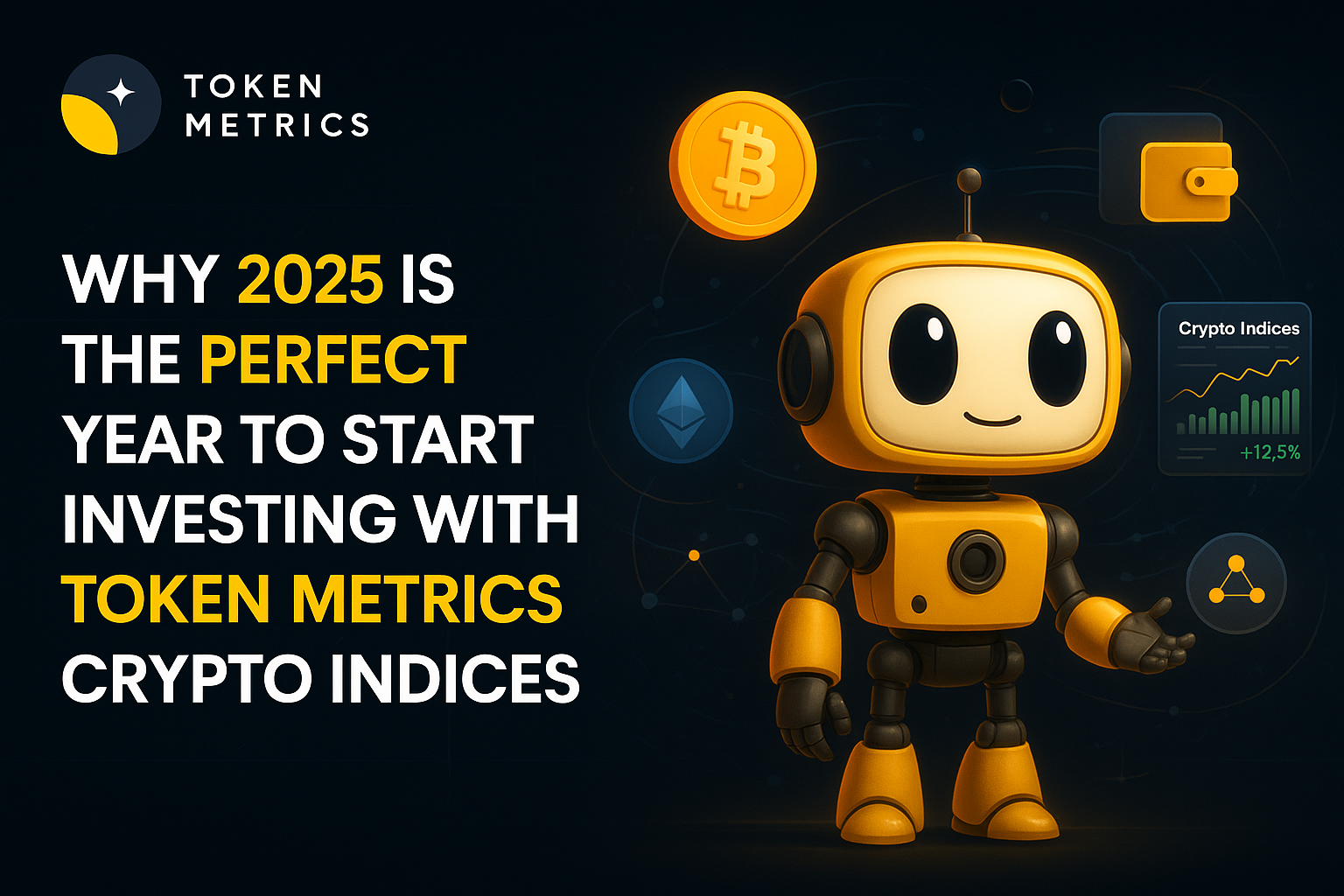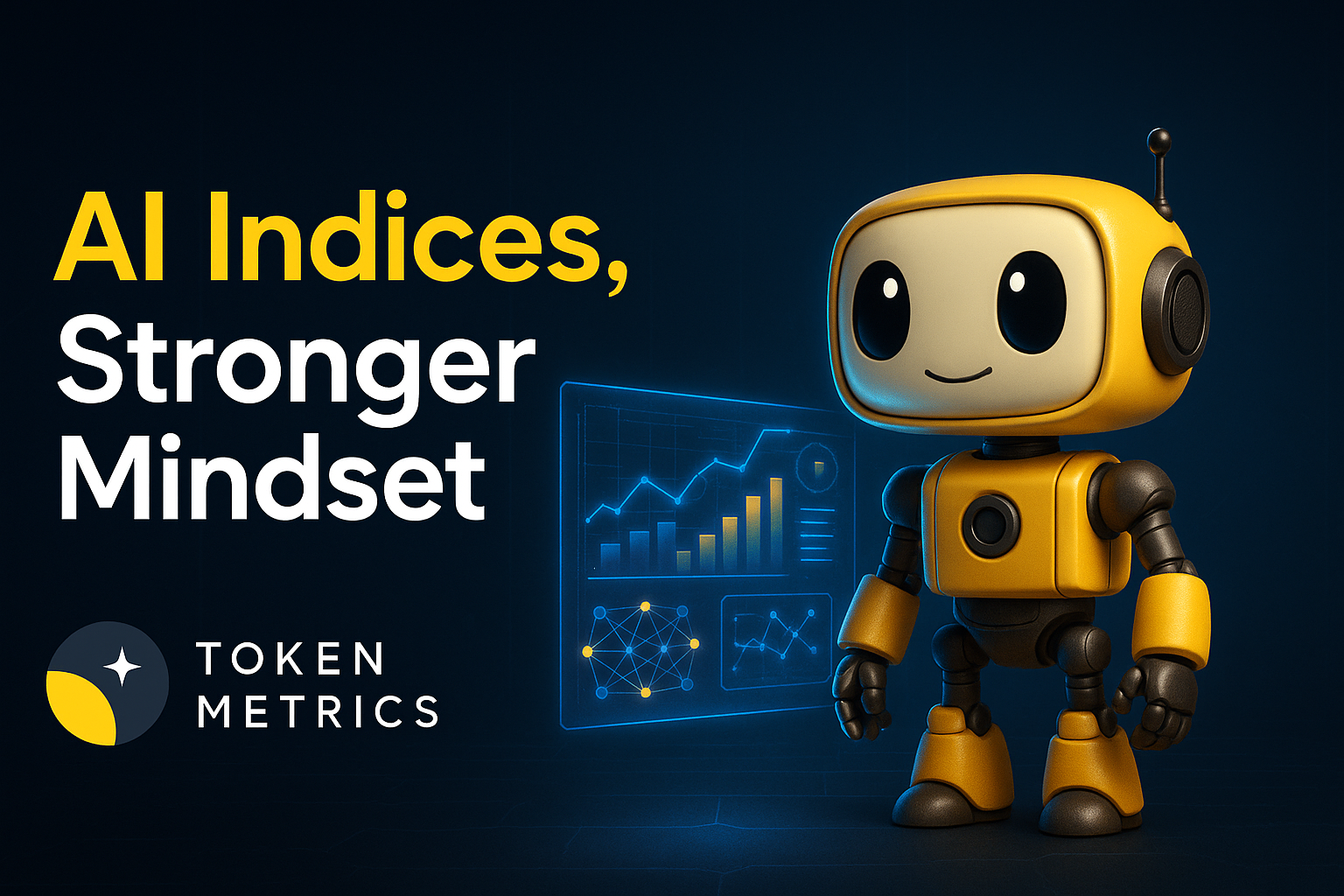
Why 2025 Is the Perfect Year to Start Investing with Token Metrics Crypto Indices

If you've been waiting for the "right time" to invest in cryptocurrency, 2025 represents a convergence of factors that may never align this perfectly again. Regulatory frameworks are solidifying. Institutional adoption is accelerating. AI technology has matured. Market infrastructure has professionalized. And most importantly, proven systems like Token Metrics AI indices have track records demonstrating consistent success through multiple market cycles.
The question isn't whether to invest in crypto—that ship has sailed as institutional giants commit billions. The question is how to invest smartly, efficiently, and with the best chance of success. Here's why 2025 is your optimal entry point, and why Token Metrics indices offer the ideal vehicle for capturing this opportunity.
Reason #1: Regulatory Clarity Is Finally Here
For years, cryptocurrency existed in regulatory limbo. Investors faced uncertainty about legal status, tax treatment, and government attitudes. That era is ending.
The European MiCA Framework
Europe's Markets in Crypto-Assets (MiCA) regulation, fully implemented in 2025, provides the first comprehensive regulatory framework for crypto markets. This standardization removes legal uncertainty and opens doors for institutional capital that previously stayed on the sidelines.
U.S. Regulatory Evolution
The approval of Bitcoin spot ETFs in 2024 marked a watershed moment. Professional investors now hold $27.4 billion in U.S. Bitcoin ETFs, signaling mainstream acceptance. Further regulatory clarity continues emerging as the SEC and other agencies develop consistent frameworks.
What This Means for You
Regulatory clarity reduces risk. When governments establish clear rules, legitimate projects thrive while scams get eliminated. Token Metrics benefits directly—its AI-powered selection process now operates in a more transparent market where quality projects are easier to identify and verify.
The Token Metrics Advantage: With regulations favoring legitimate projects, Token Metrics' fundamental analysis of team quality, code audits, and regulatory compliance becomes even more valuable. The platform automatically filters for projects meeting evolving regulatory standards.
Reason #2: Institutional Adoption Is Accelerating
Individual retail investors no longer dominate crypto markets. Institutions are entering aggressively, bringing professionalism, liquidity, and validation.
The Numbers Don't Lie
According to a Coinbase institutional survey, 67% of professional investors plan to increase their crypto holdings in 2025, with 24% expecting to "significantly increase" exposure—up from just 16% in 2024.
Family offices and hedge funds are leading this shift, reflecting growing conviction in crypto's performance advantage and structural role in diversified portfolios.
Token Metrics Institutional-Grade Approach
Token Metrics was built with institutional-quality standards from day one. The platform's AI analyzes over 80 data points per token—the same rigorous approach used by professional fund managers.
As institutions flood into crypto, having institutional-grade tools becomes essential for retail investors to compete. Token Metrics democratizes access to professional strategies that previously required million-dollar minimums and expert teams.
Reason #3: AI Technology Has Reached Maturity
Artificial intelligence in crypto investing isn't experimental anymore—it's proven, refined, and delivering consistent results.
From Experiment to Established System
Token Metrics has been developing and refining its AI models since 2017. The platform now has:
Why AI Matters More in 2025
Markets are more complex than ever. With 6,000+ cryptocurrencies, countless narratives, and 24/7 global trading, human analysis can't keep pace. AI processes information at scale, identifies patterns humans miss, and executes decisions without emotional interference.
Real-World Impact: During 2024's market volatility, Token Metrics AI indices automatically adjusted allocations, reducing exposure before major corrections and increasing positions during recoveries. Human investors watching news and making emotional decisions significantly underperformed.
The Learning Advantage
Token Metrics' AI doesn't just analyze—it learns. Every market cycle, token launch, and trend adds to the system's knowledge base. By 2025, the AI has experienced scenarios that new investors have never seen, providing a cumulative learning advantage.
Click here to signup for free trial account!
Reason #4: Market Infrastructure Has Professionalized
Remember when buying crypto meant sketchy exchanges, confusing wallets, and constant security concerns? That era is over.
Modern Crypto Infrastructure
Lower Barriers to Entry
Five years ago, investing in crypto required technical knowledge and tolerance for poor user experiences. Today, the experience matches traditional investing in ease and professionalism.
Token Metrics Simplification: The platform abstracts away remaining complexity. You don't need to understand blockchain technology or navigate confusing interfaces. Token Metrics provides clear guidance—what to buy, when to rebalance, and how to manage risk.
Reason #5: The 4-Year Bitcoin Cycle Timing
Cryptocurrency markets historically follow four-year cycles tied to Bitcoin halving events. Understanding where we are in this cycle provides strategic advantage.
The Halving Impact
Bitcoin halvings occur every four years, reducing new supply and historically triggering major bull markets. The most recent halving occurred in April 2024.
Historical Pattern:
Where We Are Now
We're in the early-to-mid phase of the post-halving bull cycle. Historically, the strongest gains occur 12-18 months after halving events. This positions 2025 as potentially the optimal year within the current cycle.
The Token Metrics Edge: Rather than trying to time individual token purchases, Token Metrics indices automatically adjust allocations based on market phase. During bull markets, the AI increases exposure to high-momentum opportunities. During corrections, it defensively reallocates to preserve capital.
Reason #6: Tokenized Real-World Assets Are Exploding
One of the most significant developments in 2025 is the tokenization of traditional assets onto blockchain infrastructure.
The Tokenization Revolution
Tokenized real-world assets (RWAs) have surged past $22.5 billion on-chain, up nearly 6% in recent months alone. This represents stocks, bonds, real estate, commodities, and other traditional assets moving onto blockchain rails.
Why This Matters: As traditional finance merges with crypto infrastructure, the total addressable market expands. Token Metrics RWA indices provide exposure to this significant emerging sector that bridges conventional and digital finance.
Institutional Bridge
RWAs provide familiar territory institutions need to increase crypto allocations. Rather than purely speculative tokens, these represent ownership in tangible assets with established valuations. This legitimacy accelerates institutional adoption and feeds broader crypto market growth.
Token Metrics RWA Index: Specifically designed to capture the tokenization trend, this index provides diversified exposure to projects building the infrastructure for traditional asset tokenization.
Reason #7: Diversification Has Never Been More Important
2025's macroeconomic environment makes diversification across asset classes essential.
Economic Uncertainty Drivers
Crypto's Diversification Benefits
Research demonstrates that modest crypto allocations of 1-3% have historically improved portfolio efficiency, delivering improved returns, higher Sharpe ratios, and limited drawdown impact when structured appropriately.
Token Metrics Solution: Rather than taking chances on individual crypto picks, indices provide systematic exposure that enhances overall portfolio diversification while actively managing crypto-specific risks through rebalancing and quality screening.
How to Capitalize on This Perfect Timing
Understanding why 2025 is optimal means nothing without action. Here is a practical roadmap for potential investors:
The 2025 Advantage Window
While crypto will exist for decades, specific windows offer optimal entry points. The current convergence of regulatory clarity, institutional adoption, AI maturity, and cycle timing creates a rare alignment.
Historical Precedent: Investors who entered during similar optimal windows in 2016 or early 2020 significantly outperformed those who waited for "more certainty." By the time most people feel comfortable, the biggest gains have already occurred.
Risk Considerations for 2025
No investment comes without risk. Understanding and managing these risks positions you for informed decision-making.
Your 2025 Decision Point
Every historic investment opportunity shares common characteristics: identifiable catalysts, improving fundamentals, and mainstream skepticism that keeps many participants on the sidelines.
In 2025, crypto checks every box. The infrastructure, regulations, and institutional participation that skeptics demanded are now in place. The technology is mature. The track records are established. Yet many investors still wait, searching for more "certainty," which often results in missed opportunities.
Token Metrics removes common barriers:
The question is whether you'll utilize this convergence of favorable factors or watch from the sidelines as another cycle passes.
Take Action Today
Optimal investment windows are rarely obvious in the moment. By the time everyone agrees crypto is "safe," the most significant opportunities may have passed.
Starting with even a modest allocation to Token Metrics indices can offer exposure to 2025's alignment of regulatory clarity, institutional adoption, AI insight, and market cycle timing. Exploring the indices gives you the chance to leverage a historically rare convergence of positive conditions.
Visit Token Metrics today, explore the indices, and take the first step toward capitalizing on this opportunity. The perfect time to invest rarely announces itself—it arrives quietly for those who are prepared.
Click here to signup for free trial account!
Discover Crypto Gems with Token Metrics AI
Token Metrics uses AI-powered analysis to help you uncover profitable opportunities in the crypto market. Get Started For Free
FAQ
What makes 2025 unique for crypto investing?
2025 brings together regulatory clarity, institutional adoption, AI advancements, and a post-halving market cycle, creating an environment with enhanced infrastructure and data-driven tools.
How does Token Metrics support smarter crypto investing?
Token Metrics utilizes AI models analyzing over 80 data points per token, providing index products, research, and automated strategies to help users navigate complex markets without extensive manual research.
Do I need technical knowledge to use crypto indices?
No, platforms like Token Metrics simplify the process, allowing users to access diversified indices and research insights with minimal technical expertise or blockchain knowledge.
What are the main risks associated with crypto investments in 2025?
Risks include market volatility, evolving regulation, technology vulnerabilities, and unpredictable cycles. Systematic, data-informed approaches and risk management strategies can help address these factors.
Can Token Metrics indices help with diversification?
Yes, Token Metrics indices are designed to provide diversified exposure to various segments of the crypto market, aiding overall portfolio risk management and balancing individual token exposure.
Disclaimer
This content is for informational and educational purposes only and does not constitute investment advice or an offer to buy or sell any cryptocurrency or financial product. Always conduct your own research and consult a qualified financial professional before making investment decisions. Past performance is not indicative of future results. Token Metrics does not guarantee any specific outcomes.

.svg)

Create Your Free Token Metrics Account

.png)




%201.svg)
%201.svg)


%201.svg)









.svg)




.png)